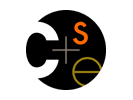
|

490GZ Project 2
|
|
Project 2 - Vector Quantization
Objectives
- Learn how to implement vector quantization training, the GLA alorithm.
- Learn how to implement fast full search for the GLA algorithm and for VQ encoding.
- Learn about the quality of VQ images by examining differing codebook
sizes and vector sizes.
Overview
Vector quantization (VQ) is a basic lossy coding method that can be used for
images, speech, and other types of data. VQ requires training which can be
very time consuming. However, using fast full search algorithms for
multidimensional data, the time for training can be reduced. In addition
fast full search algorithms can accelerate VQ encoding. In this project
you will design and implement a version of the GLA algorithm. In addition,
you will design a fast full search algorithm that can be used within the
GLA algorithm for fast encoding. You will then experiment with your
algorithm on different images to assess the quality with differing codebook
sizes and vector sizes.
Coding Assignment
What we have provided
For this project we have provide only the code necessary to take an eight
bit grayscale image in .pgm or .bmp formats and input
it as an array and to take an array and output as an image in the same format. We have also provided 5 images in the BMP format.
The files you need
- To open an image: Image im = new Image("filename.bmp")
- To write an image: im.save("output.bmp")
- Useful data members:
- im.width
- im.height
- im.pixel[i][j], i = column, j = row
What you should provide
- A README file that explains how to extract your files and explains how
to use your program. Included should be an explanation of your file
format for codebooks.
- GLA. The GLA code should take as input one or more images as a training
set and output a codebook. You may sample from the images to create the
codebook.
- Fast Full Search (FFS). The FFS should take a vector and codebook, and
return the index of the nearest codeword in the codebook. It should not
use linear search but one of the fast full search methods found in the
Zatloukal/Ladner paper or some other method found in the literature. FFS
should be used in both the GLA and in the VQ encoder.
- Encode/Decode (VQ). Both encoder and decoder have access to the same
codebook. The VQ encoder takes an image and produces an index stream.
The VQ decoder takes an index stream and outputs an image. The index
file must have a specific format as explained below.
- Two codebook files with 256 codewords each for 2 by 1 and 2 by 2 vector to be
used for testing.
Index Stream Format
So that we can compare your data compressor with others we require a
specific file format for the index stream.
- The first four bytes represent an integer of the width of
the image in blocks
and the second four bytes represent the height of the
image in blocks. Suppose you have an p x q (width by height)
image partitioned into r x s blocks then the first two numbers are are
w = p/r and h = q/s.
- The next byte is the an integer representing how many bits make up one
index. For example, if the codebook size is n, then the second, then
this byte is log2n interpreted as an integer.
- The remainder of the file is a bit stream where each k = log2 n bits is
a k-bit index. The indices are output in raster order, first row of
indices, second row of indices, and so on. Naturally, this bit stream
is represented as bytes in the file. Suppose we have a codebook of
size 128, then every 7 bits is an index, or every 7 bytes is 8
indices. The total length of the files should be k * w * h / 8 + 9 bytes.
Experimental Study
For the experimental study you will choose a lossless compressor (winzip,
bzip2, etc.) for the index stream so that you can provide a rate distortion
graph for your encoder/decoder. You should use at least three different
codebooks based on different training sets (not Barbara)
and do your testing only on the Barbara image. By choosing various codebook
sizes and vector sizes plot at least 10 different bit rates vs. PSNR to
compare the quality of the codebooks obtained from different training sets.
Write a short paper that explains the details of your
experimental setup and the results you obtained.
Contest
Turn in your codebook file which compresses Barbara to a quality of at
least 30dB PNSR. The winner will be the program whose index stream
compresses to the smallest file when compressed with Bzip2.
Your README file should indicate which of your codebook files is submitted
for the contest.
Due Date
The project is due on Monday, March 8, 2004 at 9 pm. The paper is due in class Wednesday, March 10, 2004.
There should be two files to turn in: the README file and a tar file with
everything else (including the codebooks). The README should explain how to open the tar file, how to run the programs, and what your codebook files are. Go to the turn-in page to send us these files.
|
 |
Computer Science & Engineering
University of Washington
Box 352350
Seattle, WA 98195-2350
(206) 543-1695 voice, (206) 543-2969 FAX
[comments to nchernia]
|


 CSE Home
CSE Home  About Us
About Us Search
Search Contact Info
Contact Info